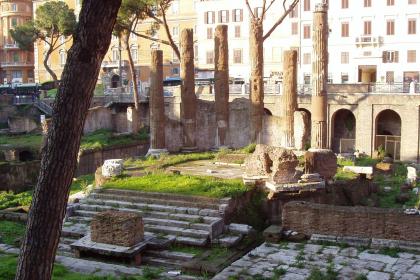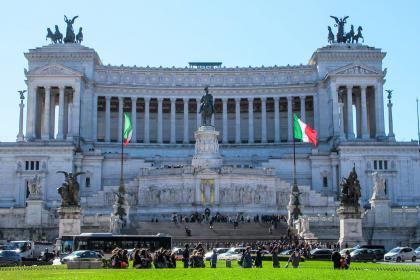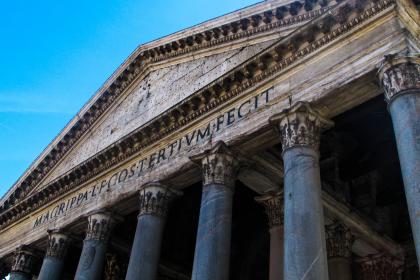
Les vestiges du temple, constitués d'une partie du podium et de deux colonnes à chapiteaux corinthiens, furent mis au jour en 1938 lors des travaux de démolition pour l'élargissement de la Via delle Botteghe Oscure, dans la zone comprise entre le Largo di Torre Argentina et la Piazza Venezia. L'édifice sacré fut probablement fondé entre la fin du IIIe et le début du IIe siècle avant J.-C. et fut dévasté par un terrible incendie, décrit par l'historien Dion Cassius, qui toucha le Campo Marzio en 80 après J.-C., sous le règne de Titus.
L'empereur Domitien, monté sur le trône l'année suivante, reconstruisit plusieurs bâtiments publics endommagés par l'incendie et en érigea de nouveaux, transformant ainsi radicalement le tissu urbain de la zone. Parmi ceux-ci, figure certainement le temple, qui fit l'objet d'une importante restauration. L'édifice, que l'on peut reconstituer grâce à un fragment de la Forma Urbis, un plan en marbre de la ville dessiné sous Septime Sévère, était périptère et octostyle, c'est-à-dire entouré de colonnes sur tous les côtés, dont huit étaient alignées sur le devant, et l'on y accédait par un escalier. Le temple était également entouré d'un quadriportique probablement érigé à l'époque de Domitien. Le mur de la cella en briques, visible avec la base de la statue de culte dans les caves du palais de la Via Celsa, appartient à une restauration de l'époque de Domitien.
Une pièce de monnaie de Valentinien III, retrouvée sur le site archéologique, a permis de dater l'abandon du temple à partir de 425 après J.-C. Cette période fut suivie d'une phase de spoliation et de transformation entre le VIe et le VIIe siècle après J.-C., pendant laquelle la zone fut occupée par d'autres structures qui n'ont pas encore été identifiées.
Photo: Sovrintendenza Capitolina
Aire sacrée de Largo di Torre Argentina

 Condividi
Condividi
Place Venezia

 Condividi
Condividi
Informations
Visible from the outside.
 Condividi
Condividi
Location
Pour connaître tous les services d'accessibilité, visitez la section Rome accessible.












































